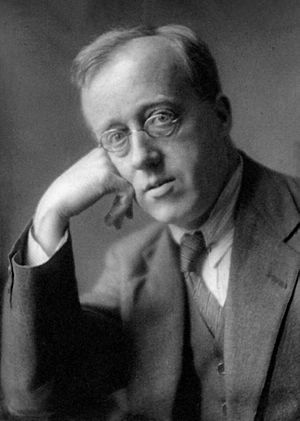St Paul's Suite facts for kids
St Paul's Suite is a famous piece of music written by Gustav Holst. He created it in 1912. It was later published in 1922 after he made some changes. This suite is mostly for a string orchestra, which means instruments like violins, violas, cellos, and double basses. It also includes a few wind instruments. Holst wrote this music especially for St Paul's Girls' School in London. He was the Director of Music there for many years. The suite has four main parts, called movements: Jig, Ostinato, Intermezzo, and Finale.
Contents
What is a Music Suite?
A music suite is a collection of different pieces of music. These pieces are usually played together. They often have a common theme or idea. In the past, suites were often made up of different types of dances. St Paul's Suite is a modern example. It brings together different musical styles and moods.
Who Was Gustav Holst?
Gustav Holst (1874–1934) was a famous British composer. He is best known for his large orchestral work, The Planets. Holst was a teacher for much of his life. He taught music at St Paul's Girls' School from 1905 to 1934. He also taught at the Royal College of Music. He cared deeply about his students. He wrote St Paul's Suite so his students could play it. This helped them improve their musical skills.
Why Was St Paul's Suite Written?
Holst wrote St Paul's Suite for the students at St Paul's Girls' School. The school had a good orchestra. Holst wanted to give them music that was fun and challenging to play. He also wanted to help them learn about different musical forms. The suite was first performed by the school's orchestra. It quickly became popular with other orchestras too.
The Movements of St Paul's Suite
The St Paul's Suite has four movements. Each movement has its own unique character.
Jig
The first movement is called "Jig." A jig is a lively and fast dance. It comes from traditional English folk music. This movement is full of energy. It has a bouncy rhythm that makes you want to tap your feet. It's a fun and exciting start to the suite.
Ostinato
The second movement is "Ostinato." An ostinato is a musical phrase that repeats over and over again. It creates a steady, hypnotic feeling. In this movement, you'll hear a repeating melody. Other parts of the orchestra play different tunes on top of it. This creates a rich and interesting sound.
Intermezzo
"Intermezzo" is the third movement. An intermezzo is usually a short piece played between larger sections. This movement is more gentle and flowing. It has a beautiful, singing melody. It provides a calm and thoughtful contrast to the faster movements.
Finale (The Dargason)
The final movement is called "Finale." It is also known as "The Dargason." This movement is very clever. It combines two different folk tunes. One is "The Dargason," an old English dance tune. The other is "Greensleeves," a very famous English folk song. Holst weaves these two melodies together. They are played at the same time. This creates a brilliant and exciting ending to the suite. It's a great example of Holst's skill in using traditional melodies in new ways.
Legacy of the Suite
St Paul's Suite is still very popular today. Orchestras around the world perform it often. It is a favorite piece for student orchestras. It helps young musicians learn important skills. It also shows Holst's love for English folk music. The suite is a wonderful example of his talent as a composer and a teacher.
See also
 In Spanish: St Paul's Suite para niños
In Spanish: St Paul's Suite para niños


